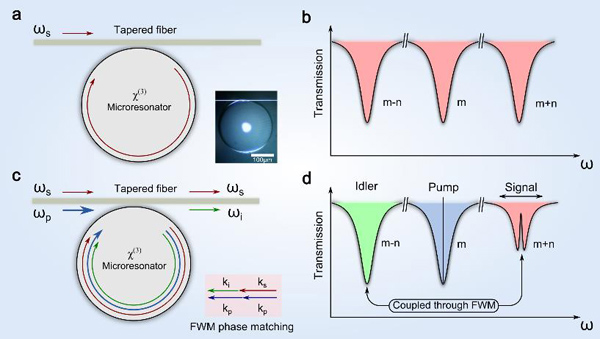Electromagnetically induced transparency (EIT) is one of the greatest discoveries to verify the quantum interference nature of atomic systems. It allows the flipping of an optical opaque transmission window to a transparent one under a secondary coherent illumination beam even at the few-photon limit, which immediately provides an opportunity for light–matter–light interactions that are in great demand by all-optical and quantum information processing. However, in most circumstances, those atoms must be prepared in gas phase, which requires optical cooling or vapor heating techniques combined with vacuum isolation, making it difficult for chip-scale integration, which are the major proposed applications.
Professor Wan’s team has theoretically and experimentally demonstrated a new scheme of an optically induced transparency in a compact micro-cavity in an ambient environment. Because the OIT relies only on the non-linearity and resonance properties of the medium, similar features should be ubiquitously expected among any other physical system with these characteristics. This system may offer a new avenue for a compact, integrated solution for all-optical processing and quantum information.
 Figure: Schematic illustration of the optically induced transparency. (a, b) Transmission spectrum of a micro-cavity through a tapered fiber. Each resonance is independent. (c, d) A strong pump wave, ωp, in the same micro-cavity generates a nonlinear FWM resulting in nonlinear coupling of the two resonances
Figure: Schematic illustration of the optically induced transparency. (a, b) Transmission spectrum of a micro-cavity through a tapered fiber. Each resonance is independent. (c, d) A strong pump wave, ωp, in the same micro-cavity generates a nonlinear FWM resulting in nonlinear coupling of the two resonances
This project is supported by the National Natural Science Foundation of China, the National 1000-talent Program (Youth), the Shanghai Pujiang Talent Program and the Shanghai Scientific Innovation Program.
Light: Science & Applications (LSA) is an open access, online-only journal. It is co-published by Nature Publishing Group (NPG) and the Changchun Institute of Optics, Fine Mechanics and Physics (CIOMP); and managed by Chinese Academy of Sciences. LSA aims to publish original articles and reviews that are of high quality, strong interest and far-reaching consequence in optics and photonics, as well as covering traditional topics in optical engineering. The journal publishes. LSA has an impact factor of 14.603 in 2014, ranking 2/86 in the optical field.





